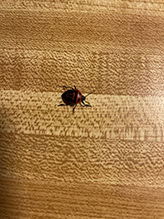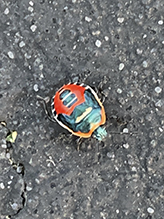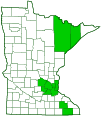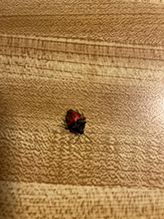two-spotted stink bug
(Perillus bioculatus)
Conservation • Description • Habitat • Ecology • Distribution • Taxonomy
|
|
||||||||||||||
Description |
Two-spotted stink bug is a common, widespread, predatory stink bug. It occurs throughout the United States, southern Canada, and Mexico. In the U.S. it is mostly absent from the deep south with the exception of the Florida peninsula. Both adults and nymphs feed on the eggs and larvae principally of Colorado potato beetle. It has also been reported feeding on other beetle larvae, including goldenrod leaf beetle, ragweed leaf beetle, Zygogramma heterothecae, cottonwood leaf beetle, and Mexican bean beetle. In Minnesota, adults are active mostly from late May to October. In areas with mild winters, they may be active year round. They are found in and near agricultural crops, including potato fields, and in gardens, landscapes, and natural areas. Two-spotted stink bugs are considered beneficial because they prey on Colorado potato beetle, an agricultural pest. However, they rarely occur in numbers high enough to cause a significant reduction in beetle infestations. Adults are 5⁄16″ to 7⁄16″ (8.5 to 11.0 mm) in length. The body is somewhat shield-shaped, appearing broad-shouldered. There are two color forms. The red form is red or orange and black, the yellow form is white or yellow and black. The red color comes from ingesting the Colorado potato beetle, which has carotene pigment. If the pigment is not metabolized quickly enough, it is directed into the exoskeleton. This process is primarily controlled by temperature. Once it occurs, the color change is permanent. The following description is of the red form. The head is black. There are two large, bulging, compound eyes and two small simple eyes (ocelli). The front of the head is divided into a central lobe (tylus) and two lateral lobes (juga). The juga are slightly longer than the tylus. The beak-like projection of the head (rostrum) is long, it is very thick, and it has four segments. The first segment is thickened and free, enabling it to be swung fully forward. At the base of the rostrum there is a pair of raised plates (buccula). The bucculae are very short and cover only the base of the first segment of the rostrum. The antennae are black and have five segments. The first segment is often pale, the second segment is sometimes pale. The exoskeletal plate covering the thorax (pronotum) has a rounded, outward projection in the shoulder (humeral) areas. It is red with a broad black band which sometimes covers most of the pronotum. The band is interrupted in the middle, forming two spots. This is the feature that gives the insect its common name. The plate between the wing bases (scutellum) is large. It is broadly triangular at the base, and it has a U-shaped lobe at the tip. The lobe does not reach the tip of the abdomen. It is red on the margins with a broad, black, Y-shaped or keyhole-shaped mark in the middle. There are two pairs of wings, and they are held flat over the body when at rest. The forewings (hemelytra) are as long as the abdomen but do not completely cover the sides of the abdomen. The exposed sides are black with red margins. The hemelytra are black. They have a thickened, leathery section at the base and a thin membranous section at the tip with a clear dividing line between the two. The thickened basal part is comprised of a narrow area (clavus) behind the scutellum when the wings are closed, and the remaining broad marginal area (corium). On yellow form individuals, the corium often has a broad yellow border. The underside of the abdomen is red. On each side there is a submarginal row of black spots that sometimes coalesce into a stripe, and a marginal row of black spots, each spot surrounding a breathing pore (spiracle). The legs are black. On the middle and hind legs there is a white band on the tibia just before the middle. The nymph is round to oval, somewhat flattened on the underside, and 1⁄16″ to ⅜″ (1.5 to 9.0 mm) in length. The head, thorax, and legs are black and shiny with greenish reflections. The abdomen is black in the center with three white bands. The black area is surrounded by a more or less circular red, orange, or tan area. There are four large black spots on each lateral margin. On later stage (instar) nymphs, the developing wing covers are black and conspicuous. |
Size |
Total length: 5⁄16″ to 7⁄16″ (8.5 to 11.0 mm) |
Similar Species |
Habitat |
Agricultural crops, gardens, landscapes, and natural areas |
Ecology |
Season |
Two generations per year from late May to October in Minnesota, three generations in the south. |
Behavior |
The first four instars feed in groups. |
Life Cycle |
In September or October, adults seek a place to overwinter. This may be in the soil, under plant debris, or in a house. They emerge the following year in late May or June. The female lays clutches of 10 to 25 eggs in two rows. She may lay 100 to 300 eggs in her lifetime. |
Nymph Food |
First instars feed on plant juices. Later instars feed on eggs and larvae principally of Colorado potato beetle, but also other beetle larvae, including goldenrod leaf beetle, ragweed leaf beetle, Zygogramma heterothecae, cottonwood leaf beetle, and Mexican bean beetle. |
Adult Food |
Larvae principally of Colorado potato beetle, but also other beetle larvae, including goldenrod leaf beetle, ragweed leaf beetle, Zygogramma heterothecae, cottonwood leaf beetle, and Mexican bean beetle |
Distribution |
||
|
Sources |
|
| 3/3/2024 | ||
Occurrence |
||
|
||
Taxonomy |
|
Order |
Hemiptera (True bugs, Hoppers, Aphids, and Allies) |
Suborder |
Heteroptera (True Bugs) |
Infraorder |
Pentatomomorpha |
Superfamily |
Pentatomoidea (stink bugs, shield bugs, and allies) |
Family |
|
Subfamily |
Asopinae (predatory stink bugs) |
Genus |
Perillus |
Subordinate Taxa |
|
|
|
Synonyms |
|
|
|
Common Names |
|
double-eyed soldier bug two spotted stink bug twospotted stink bug two-spotted stink bug |
|
Glossary
Hemelytron
The forewing of true bugs (order Hemiptera), thickened at the base and membranous at the tip. Plural: hemelytra.
Instar
The developmental stage of arthropods between each molt; in insects, the developmental stage of the larvae or nymph.
Pronotum
The exoskeletal plate on the upper side of the first segment of the thorax of an insect.
Scutellum
The exoskeletal plate covering the rearward (posterior) part of the middle segment of the thorax in some insects. In Coleoptera, Hemiptera, and Homoptera, the dorsal, often triangular plate behind the pronotum and between the bases of the front wings. In Diptera, the exoskeletal plate between the abdomen and the thorax.
Spiracle
A small opening on the surface of an insect or arachnid through which it breathes.
Tibia
The fourth segment of an insect leg, after the femur and before the tarsus (foot). The fifth segment of a spider leg or palp. Plural: tibiae.
Visitor Photos |
||
Share your photo of this insect. |
||
This button not working for you? |
||
Heather |
||
 |
||
|
||
Brian B. Gibbens |
||
Mystery Beetle I was walking home today and I saw a beetle the likes of which I have never seen before. It was found on a sidewalk in Shoreview, MN. Any ideas what this might be? I did not spot it in your list.somewhat shield-shaped, appearing broad-shouldered |
 |
|
MinnesotaSeasons.com Photos |
||
|
||
|
||

Visitor Videos |
||
Share your video of this insect. |
||
This button not working for you? |
||
|
Other Videos |
||
Perillus bioculatus |
About
Oct 17, 2022 Perillus bioculatus |

Visitor Sightings |
||
Report a sighting of this insect. |
||
This button not working for you? |
||
Heather |
Location: Wright County, MN |
 |
MinnesotaSeasons.com Sightings |
||
|

Created: 9/17/2023 Last Updated: © MinnesotaSeasons.com. All rights reserved. |




